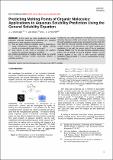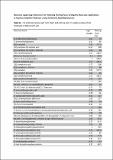Files in this item
Predicting melting points of organic molecules : applications to aqueous solubility prediction using the General Solubility Equation
Item metadata
| dc.contributor.author | McDonagh, James | |
| dc.contributor.author | van Mourik, Tanja | |
| dc.contributor.author | Mitchell, John B. O. | |
| dc.date.accessioned | 2016-07-19T23:30:54Z | |
| dc.date.available | 2016-07-19T23:30:54Z | |
| dc.date.issued | 2015-11 | |
| dc.identifier | 193879041 | |
| dc.identifier | e08590a9-e2c8-46b0-a3d8-db34e67ab1e1 | |
| dc.identifier | 84947865153 | |
| dc.identifier | 000365318600002 | |
| dc.identifier.citation | McDonagh , J , van Mourik , T & Mitchell , J B O 2015 , ' Predicting melting points of organic molecules : applications to aqueous solubility prediction using the General Solubility Equation ' , Molecular Informatics , vol. 34 , no. 11-12 , pp. 715-724 . https://doi.org/10.1002/minf.201500052 | en |
| dc.identifier.issn | 1868-1743 | |
| dc.identifier.other | ORCID: /0000-0002-0379-6097/work/34033383 | |
| dc.identifier.other | ORCID: /0000-0001-7683-3293/work/57088463 | |
| dc.identifier.uri | https://hdl.handle.net/10023/9174 | |
| dc.description.abstract | In this work we make predictions of several important molecular properties of academic and industrial importance to seek answers to two questions: 1) Can we apply efficient machine learning techniques, using inexpensive descriptors, to predict melting points to a reasonable level of accuracy? 2) Can values of this level of accuracy be usefully applied to predicting aqueous solubility? We present predictions of melting points made by several novel machine learning models, previously applied to solubility prediction. Additionally, we make predictions of solubility via the General Solubility Equation (GSE) and monitor the impact of varying the logP prediction model (AlogP and XlogP) on the GSE. We note that the machine learning models presented, using a modest number of 2D descriptors, can make melting point predictions in line with the current state of the art prediction methods (RMSE ≥ 40 oC). We also find that predicted melting points, with an RMSE of tens of degrees Celsius, can be usefully applied to the GSE to yield accurate solubility predictions (log10S RMSE < 1) over a small dataset of druglike molecules. | |
| dc.format.extent | 1687972 | |
| dc.format.extent | 962026 | |
| dc.language.iso | eng | |
| dc.relation.ispartof | Molecular Informatics | en |
| dc.subject | Machine learning | en |
| dc.subject | Melting points | en |
| dc.subject | Pharmaceuticals | en |
| dc.subject | QSPR | en |
| dc.subject | Solubility | en |
| dc.subject | QD Chemistry | en |
| dc.subject | NDAS | en |
| dc.subject.lcc | QD | en |
| dc.title | Predicting melting points of organic molecules : applications to aqueous solubility prediction using the General Solubility Equation | en |
| dc.type | Journal article | en |
| dc.contributor.institution | University of St Andrews. School of Chemistry | en |
| dc.contributor.institution | University of St Andrews. EaSTCHEM | en |
| dc.contributor.institution | University of St Andrews. Biomedical Sciences Research Complex | en |
| dc.identifier.doi | 10.1002/minf.201500052 | |
| dc.description.status | Peer reviewed | en |
| dc.date.embargoedUntil | 2016-07-20 | |
| dc.identifier.url | http://onlinelibrary.wiley.com/doi/10.1002/minf.201500052/abstract | en |
This item appears in the following Collection(s)
Items in the St Andrews Research Repository are protected by copyright, with all rights reserved, unless otherwise indicated.


